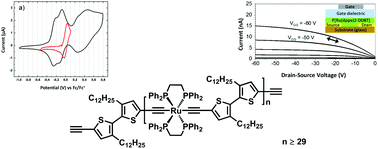当前位置:
X-MOL 学术
›
Polym. Chem.
›
论文详情
Our official English website, www.x-mol.net, welcomes your
feedback! (Note: you will need to create a separate account there.)
Synthesis and characterization of a semiconducting and solution-processable ruthenium-based polymetallayne†
Polymer Chemistry ( IF 4.1 ) Pub Date : 2019-10-04 , DOI: 10.1039/c9py01090d Po-Yuen Ho 1, 2, 3, 4, 5 , Hartmut Komber 1, 2, 3 , Kilian Horatz 1, 2, 3, 4, 5 , Takuya Tsuda 1, 2, 3, 4, 5 , Stefan C. B. Mannsfeld 3, 4, 4, 5, 6 , Evgenia Dmitrieva 2, 3, 7 , Olivier Blacque 8, 9, 10, 11 , Ulrike Kraft 12, 13, 14, 15 , Henning Sirringhaus 12, 13, 14, 15 , Franziska Lissel 1, 2, 3, 4, 5
Polymer Chemistry ( IF 4.1 ) Pub Date : 2019-10-04 , DOI: 10.1039/c9py01090d Po-Yuen Ho 1, 2, 3, 4, 5 , Hartmut Komber 1, 2, 3 , Kilian Horatz 1, 2, 3, 4, 5 , Takuya Tsuda 1, 2, 3, 4, 5 , Stefan C. B. Mannsfeld 3, 4, 4, 5, 6 , Evgenia Dmitrieva 2, 3, 7 , Olivier Blacque 8, 9, 10, 11 , Ulrike Kraft 12, 13, 14, 15 , Henning Sirringhaus 12, 13, 14, 15 , Franziska Lissel 1, 2, 3, 4, 5
Affiliation

|
Polymetallaynes are a special class of Wolf type-III polymers with high potential in organic electronics, especially in applications such as OFET, OLED and OPV. However, almost all reported polymetallaynes contain group 10 metals, while functional polymetallaynes with earlier transition metals have rarely been reported. Here, different synthetic routes to a group 8 polymetallayne P[Ru(dppe)2-DDBT], containing Ru(II) centers bridged in the trans-position by the organic linker 3,3′-didodecyl-5,5′-diethynyl-2,2′-bithiophene (DDBT), are explored. The polymer is obtained by copper-free dehydrohalogenation, characterized using NMR, IR and UV-vis spectroscopy, MALDI-TOF-MS, GPC and CV. In solution, CV studies show two separated metal-centered redox processes, indicating that the charge between metal centers is delocalized via the bridging ligand and a mixed-valence species exists (Kc = 102). In thin-films, P[Ru(dppe)2-DDBT] exhibits a single oxidation wave with a higher peak current intensity, consistent with a two-electron process and localized charge. Despite a degree of polymerization ∼32 based on NMR and GPC studies, P[Ru(dppe)2-DDBT] is fully solution processable, and thin-films were obtained via spin-coating using different solvents. AFM investigations of the films showed very low surface roughness, and first OFET devices with a top-gate bottom-contact (TGBC) architecture were fabricated to characterize the electronic properties, confirming the semiconducting behaviour of the polymetallayne.
中文翻译:

半导体和可溶液处理的钌基多金属芳烃的合成与表征†
聚金属硅酮是一类特殊的Wolf型III型聚合物,在有机电子领域具有很高的潜力,尤其是在OFET,OLED和OPV等应用中。但是,几乎所有已报道的多金属锰都含有第10组金属,而鲜有过渡金属的功能性多金属硅则鲜有报道。在这里,不同的合成路线是由有机连接基3,3'-didodecyl-5,5'- diethynynyl跨位连接的包含Ru(II)中心的第8组多金属茂P [Ru(dppe)2 -DDBT] -2,2'-联噻吩(DDBT),进行了探索。该聚合物是通过无铜脱卤化氢获得的,其特征在于使用NMR,IR和UV-vis光谱,MALDI-TOF-MS,GPC和CV进行表征。在溶液中,CV研究显示了两个分离的以金属为中心的氧化还原过程,表明金属中心之间的电荷通过桥联配体而离域,并且存在混合价态物种(K c = 10 2)。在薄膜中,P [Ru(dppe)2 -DDBT]表现出具有较高峰值电流强度的单氧化波,与双电子过程和局部电荷一致。尽管根据NMR和GPC研究显示聚合度约为32,但P [Ru(dppe)2 -DDBT]可以完全溶液加工,并且使用不同的溶剂通过旋涂获得了薄膜。薄膜的原子力显微镜研究表明其表面粗糙度非常低,并且首先制造了具有顶栅底接触(TGBC)结构的OFET器件以表征电子性能,从而确认了多金属硅的半导体性能。
更新日期:2020-01-02
中文翻译:

半导体和可溶液处理的钌基多金属芳烃的合成与表征†
聚金属硅酮是一类特殊的Wolf型III型聚合物,在有机电子领域具有很高的潜力,尤其是在OFET,OLED和OPV等应用中。但是,几乎所有已报道的多金属锰都含有第10组金属,而鲜有过渡金属的功能性多金属硅则鲜有报道。在这里,不同的合成路线是由有机连接基3,3'-didodecyl-5,5'- diethynynyl跨位连接的包含Ru(II)中心的第8组多金属茂P [Ru(dppe)2 -DDBT] -2,2'-联噻吩(DDBT),进行了探索。该聚合物是通过无铜脱卤化氢获得的,其特征在于使用NMR,IR和UV-vis光谱,MALDI-TOF-MS,GPC和CV进行表征。在溶液中,CV研究显示了两个分离的以金属为中心的氧化还原过程,表明金属中心之间的电荷通过桥联配体而离域,并且存在混合价态物种(K c = 10 2)。在薄膜中,P [Ru(dppe)2 -DDBT]表现出具有较高峰值电流强度的单氧化波,与双电子过程和局部电荷一致。尽管根据NMR和GPC研究显示聚合度约为32,但P [Ru(dppe)2 -DDBT]可以完全溶液加工,并且使用不同的溶剂通过旋涂获得了薄膜。薄膜的原子力显微镜研究表明其表面粗糙度非常低,并且首先制造了具有顶栅底接触(TGBC)结构的OFET器件以表征电子性能,从而确认了多金属硅的半导体性能。











































 京公网安备 11010802027423号
京公网安备 11010802027423号